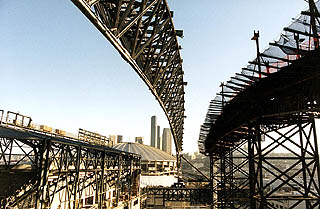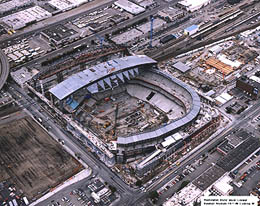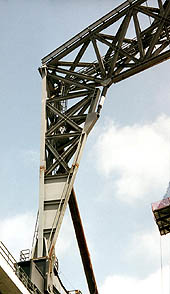|
Subscribe / Renew |
|
|
Contact Us |
|
| ► Subscribe to our Free Weekly Newsletter | |
| home | Welcome, sign in or click here to subscribe. | login |
Safeco Field
|
|
That's one big umbrella
By JON MAGNUSSON and KURT NORDQUIST
Skilling provided the structural engineering services to NBBJ, the architect with full responsibility over the design of the new ballpark. The wheel system and controls were designed and built by Seattle's Ederer Crane Co.
A short history of retractable-roof ballparksTo understand what is new and different about the roof at Safeco Field, it is helpful to look at past retractable-roof ballparks. So far, this type of structure exists only in North America. Montreal has a stadium, built for the 1976 Olympics, that has a fabric roof. The fabric roof was not installed as part of the initial construction, but was erected later. However, there have been several operational problems with that roof. Two previous retractable roofs have rigid structures like Seattle's: Toronto's Skydome and Phoenix's Bank One Ballpark. Both of these roofs retract to open the "ceiling" of the stadium to the sky, but the walls of the stadiums do not move. These roofs work like a sunroof in a car. The roof of Safeco Field expands on the car sunroof analogy, taking it all the way to a convertible. The sides move along with the roof, to provide a feeling of complete outdoors.
"Parking" the roof
This storage space keeps the retracted roof from casting shadows on the field during game time and also allows virtually every seat in the ballpark to have blue sky overhead, unlike previous retractable-roof stadiums.
A moving support systemThe legs supporting the roof also contribute to the feeling of openness for fans attending the game, as well as help reduce the construction cost. To understand why, a short physics example is helpful. As a moving weight travels across a supporting structure, each and every stationary piece beneath must be designed to support the weight. For example, if there were 40 vertical supports, all 40 would have to be able to carry the full load as it passes overhead. However, if the support beneath actually traveled with the moving weight, then only that moving support would have to carry the weight. In more practical terms, the stationary support system would cost 40 times more than the system that moves with the roof. Safeco Field is the first ballpark to take advantage of this concept of moving support.
Unique design featuresThree other design elements contributed to reducing the overall cost of the roof: straight tracking, panel independence, and optimum geometric layout. The Toronto Skydome and a new ballpark under construction in Milwaukee both include curved-track systems. The Skilling concept utilizes straight tracks, which allowed Ederer to take advantage of proven cost-saving systems in their design of the moving mechanisms.
One additional major cost-saving measure was sizing the roof to fit perfectly over the seating bowl below. Each panel of the roof is a parallelogram in plan, rather than a rectangle. An 8-degree skew of the roof minimizes its area while still covering the field. Overall, the many cost-saving techniques allowed the roof to be built for about $70 million, significantly less than the original $100 million estimate.
Wind storms on game day?One of the most critical design requirements for the Safeco Field roof was providing wind resistance during storms. In many ways, the roof is more like a long-span bridge than a building, and the Northwest has seen what wind can do to bridges (read: Tacoma Narrows)!
When in the extended or retracted positions, the roof sections have lock-down devices that tie them to the support below, to provide additional wind resistance. If there is a forecast of storm winds, the roof will not be moved between the lock-down positions.
What about earthquakes?The location is also subject to the possibility of major earthquakes. In fact, Safeco Field has already been through over 30 major earthquakesnot real earthquakes, but computer simulations. Detailed mathematical models were created representing every part of the real ballpark. This analysis was used to predict how much the building will sway in an earthquake so that the appropriate strength was built into the real structure. Since an earthquake can occur at any time, even while the roof is moving from one position to the other, the computer simulation had to be repeated with the roof in all possible positions to be sure that the "worst-possible" conditions were covered.
Big-time shock absorbersOne more Safeco Field feature that has not been used in any other ballpark, or even any other building of this scale, is the incorporation of shock absorbers in the roof system. At the top of the north legs of the roof, eight large shock absorbers have been installed to reduce the sway and forces caused by both windstorms and earthquakes. These devices, which cost about $700,000, saved over $4.5 million worth of structural steel. Even before the first pitch, the unique and cost-saving technology used on Safeco Field is now being copied on other ballparks throughout the country.
Jon Magnusson is chief executive officer of Skilling Ward Magnusson Barkshire and Kurt Nordquist is vice president.
 djc home | top | special issues index
|




